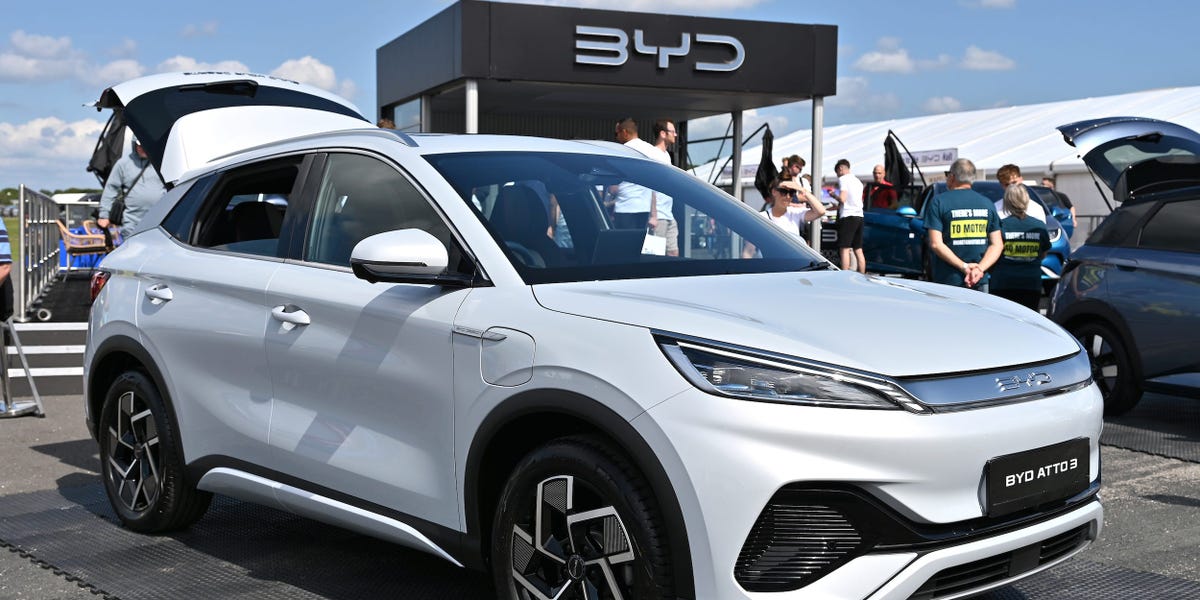- cross-posted to:
- technology@lemmy.world
- cross-posted to:
- technology@lemmy.world
deleted
This company I’ve never heard of is appearing everywhere in social media. Obviously they’re spending big to get attention with advertorials and then social media links to said content.
BYD employ about 570,000 people and by some measures are the largest carmaker in the world. I’d never heard of them either until a couple years ago. They’ve definitely got the cash to put into PR like this. Past couple years Australia started importing their electric cars. https://en.wikipedia.org/wiki/BYD_Company
Wow. There ya go. Talk about little old me living in my bubble
All of us not grokking the pace of development in China. 🤭
Here’s the summary for the wikipedia article you mentioned in your comment:
BYD Company Limited or BYD (Chinese: 比亚迪; pinyin: Bǐyǎdí) is a publicly listed Chinese conglomerate manufacturing company headquartered in Shenzhen, Guangdong, China. It was founded by Wang Chuanfu in February 1995. The company has several major subsidiaries: BYD Auto that produces vehicles, BYD Electronic that produces electronic parts and assembly and FinDreams that produces automotive components.BYD's subsidiary BYD Auto is the world's largest electric vehicle manufacturer, and is a major manufacturer in automobiles (battery electric and hybrid cars, buses, trucks, etc.). Through other subsidiaries, BYD also produces forklifts, solar panels and rechargeable batteries (mobile phone batteries, electric vehicle batteries and bulk storage). Over the past decade, the main business income proportion from the automobile business has remained consistently above 50%.
This was my exact thought as well. China saturated their own market with highly subsidized EVs and now their trying to do the same with every other market.
It’s probably marketing for V2L specifically I think.
It allows EVs to backfeed power through the charger cable into your home’s circuit breaker via a safety switchover, (if specced during charger installation - I doubt that feature was used here though) and doesn’t necessarily require the vehicle to be powered up. I.e. the car just behaves like a battery and a 2-4kW inverter for your home AFAIK.
You could probably do the same thing manually with an ICE, maybe would want to run the engine at least though, as the built in starter batteries won’t last too long and don’t like deep cycling. A death cable would technically work, but you’d really want a switchover box in a proper installation to not kill line operators repairing a power fault, and to retain proper GFCI operation
A lot of the more expensive EVs have this built in, although they don’t really publicly mention it for some reason. Ford’s F150 lightning is a really blatant example of this, it supposedly carries a much beefier inverter than average, but they’ve hidden the info behind a tiny link at the bottom of the webpage. It’s not even shown in the specifications grid.
The lack of exposure for this particular feature of EVs and PHEVs is kind of baffling to me. The ability to use your vehicle essentially as a UPS for your home is huge. My Outlander PHEV is capable of V2H through its CHAdeMO port but finding the equipment to actually use it seems just about impossible.
Even without special equipment though it has two 120V AC outlets and is rated for a combined output of 1500W through them. Definitely nice to have in a pinch. With a fully charged battery and full tank of gas it could run those outlets at maximum load for about a week.
Because vehicle to load (V2L) is a popular selling point of EVs. While the article isn’t clear, it sounds like this is what they already had installed and used.
V2L is not the same as those inverters. The inverters can only provide enough power for a few outlets (~3,000 Watts or so, depending) and for a relatively brief time (looks like most are 600-1500 Wh, meaning 1 hour of a single US 120v outlet at capacity). They must be purchased separately (which can be a problem once the need first arises, since they are not a common preventative option), and then manually connected all the way from car to device.
V2L, however, is very different. It is purchased and configured when the vehicle charging circuit is installed. It connects directly to the mains line, meaning that the feature simply needs to be turned on. Devices you want to power are still plugged into the wall. This feature can often supply 50 amps @ 240v, or 12,000 Watts.
Then there’s the issue of capacity. The battery used to start an ICE isn’t even playing the same sport as an EV battery. The high end noted above is 1,500 Wh (1.5 kWh). The Tesla model 3 has one that’s 50,000 Wh (50 kWh), while the F150 lightning has 98,000 Wh (98 kWh) and an option for 131,000 Wh (131 kWh). While an ICE can act as a generator, I’m not even going to try to get an estimate on capacity. Way too many variables involved.
As for why the article focused on that brand/model, I think it’s more about tugging at the heart strings. It’s less about the brand and more about putting a face on why the feature was helpful/important. But I agree that it was written in a way that focused way too heavily on the brand and feels like an ad.
Capacity?
deleted
There’s also the whole … Max output from a Ford F-150 Lightning is 9.6 kilowatts vs 2.4 kilowatts from the Ford F150 ProPower’s inverter (which might come in handy if there’s a large spike in the power draw).
The inverter per your source … and my understanding of it … gets you 85 hours at 2.4k, the EV gets you 41 (based on a continuous draw of 2.4k).
The other thing worth noting though is the inverter provides outlets. An EV system can be basically directly wired into a home electrical system powering the whole home and there’s no concern about a truck running in the garage pumping out carbon monoxide. In theory it could even be automatic but I’m not sure we’re there yet.
https://www.jdpower.com/cars/shopping-guides/what-is-ford-pro-power-onboard
https://www.caranddriver.com/features/a39493654/can-your-ev-power-your-house/
I’m suprised the family didn’t have UPS & generator at their house when a member’s life depends on a running machine. It’s not like many people built batteries in their homes just to store their solar energy. I highly doubt that a BYD is cheaper than a generator.
This is the best summary I could come up with:
An Australian woman used her BYD electric car to run her son’s dialysis machine after a huge storm left her without power.
After flash flooding knocked out electricity across southeast Queensland on Christmas Day, Kristy Holmes used her Atto 3, which is made by Chinese EV giant and Tesla rival BYD, to power her 11-year-old son’s dialysis machine, according to a Guardian report.
Holmes told The Guardian that her son Levi, who is waiting to receive a kidney transplant, could have faced life-threatening consequences were it not for the Atto 3’s “vehicle to load” feature, which allows it to charge household appliances with excess power from the car’s battery.
The fact that some EVs are capable of acting as power generators on wheels makes them especially useful during major blackouts caused by extreme weather and natural disasters.
When Hurricane Ian hammered the Florida coast in 2022, Ford saw a 127% increase in the number of people using their F-150 lightning electric pickups as power sources.
Ford CEO Jim Farley posted on X that hurricane-hit drivers were using their trucks to cook meals and power lights.
The original article contains 371 words, the summary contains 185 words. Saved 50%. I’m a bot and I’m open source!






